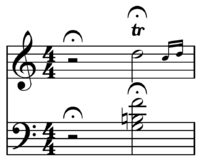
Back كادنزا Arabic Kadenz (Instrumentalkonzert) German Καντέντσα Greek Kadenco (konĉerto) Esperanto Cadenza Spanish کادنزا (موسیقی) Persian Cadence de soliste French Caidéinse Irish Cadenza Galician קדנצה (סולו) HE
In music, a cadenza, (from Italian: cadenza [kaˈdɛntsa], meaning cadence; plural, cadenze [kaˈdɛntse]) is, generically, an improvised or written-out ornamental passage played or sung by a soloist(s), usually in a "free" rhythmic style, and often allowing virtuosic display. During this time the accompaniment will rest, or sustain a note or chord. Thus an improvised cadenza is indicated in written notation by a fermata in all parts. A cadenza will usually occur over either the final or penultimate note in a piece, the lead-in (German: Eingang),[2] or the final or penultimate note in an important subsection of a piece. A cadenza can also be found before a final coda or ritornello.[3]
- ^ Sir George Grove (1904). Grove's Dictionary of Music and Musicians, Vol. 1, p. 442. John Alexander Fuller-Maitland, ed. Macmillan Company.
- ^ Keefe, Simon P. (2003). The Cambridge Companion to Mozart. Cambridge University Press. p. 265. ISBN 9781139826648.
- ^ Randel 2003.
© MMXXIII Rich X Search. We shall prevail. All rights reserved. Rich X Search
